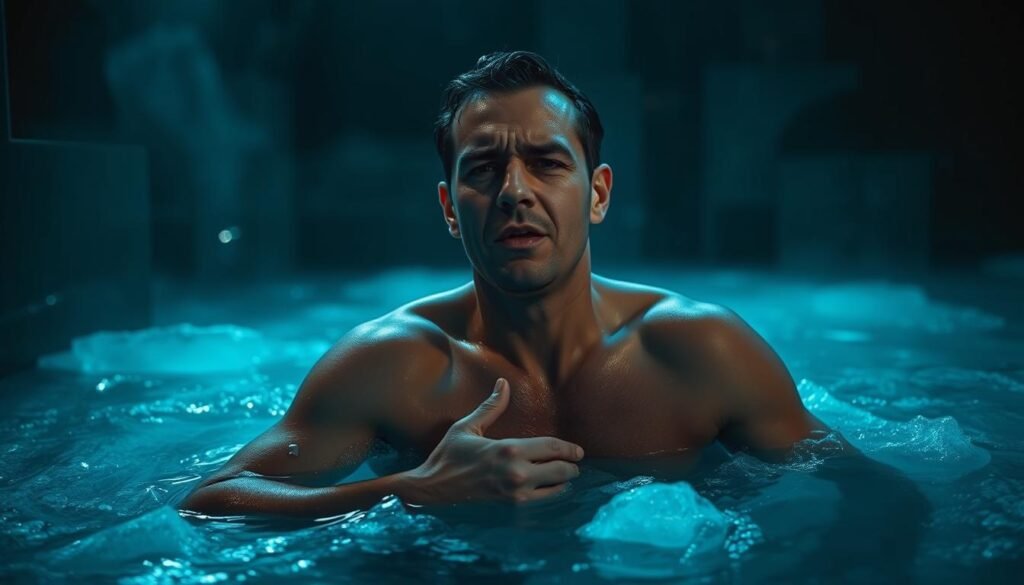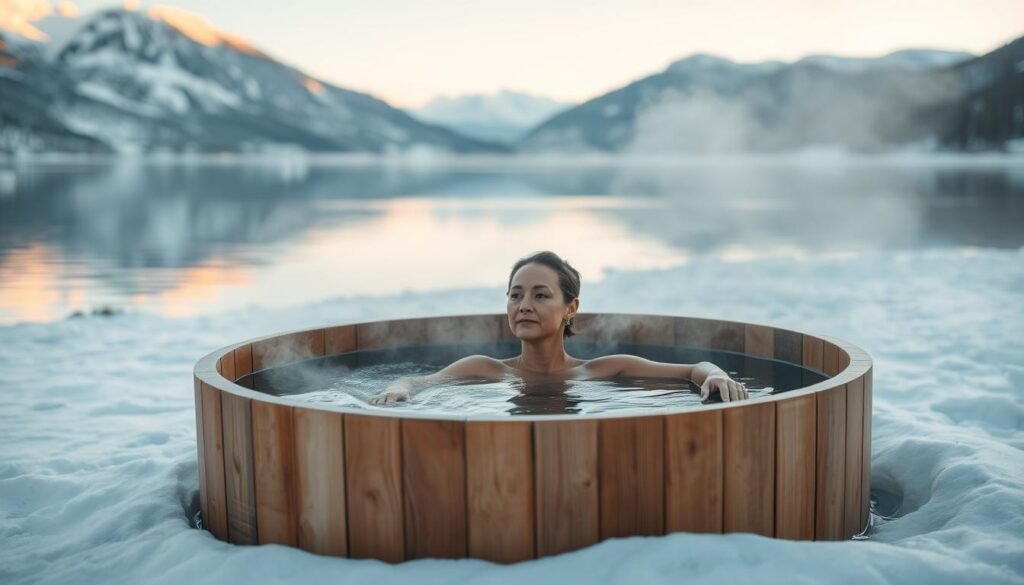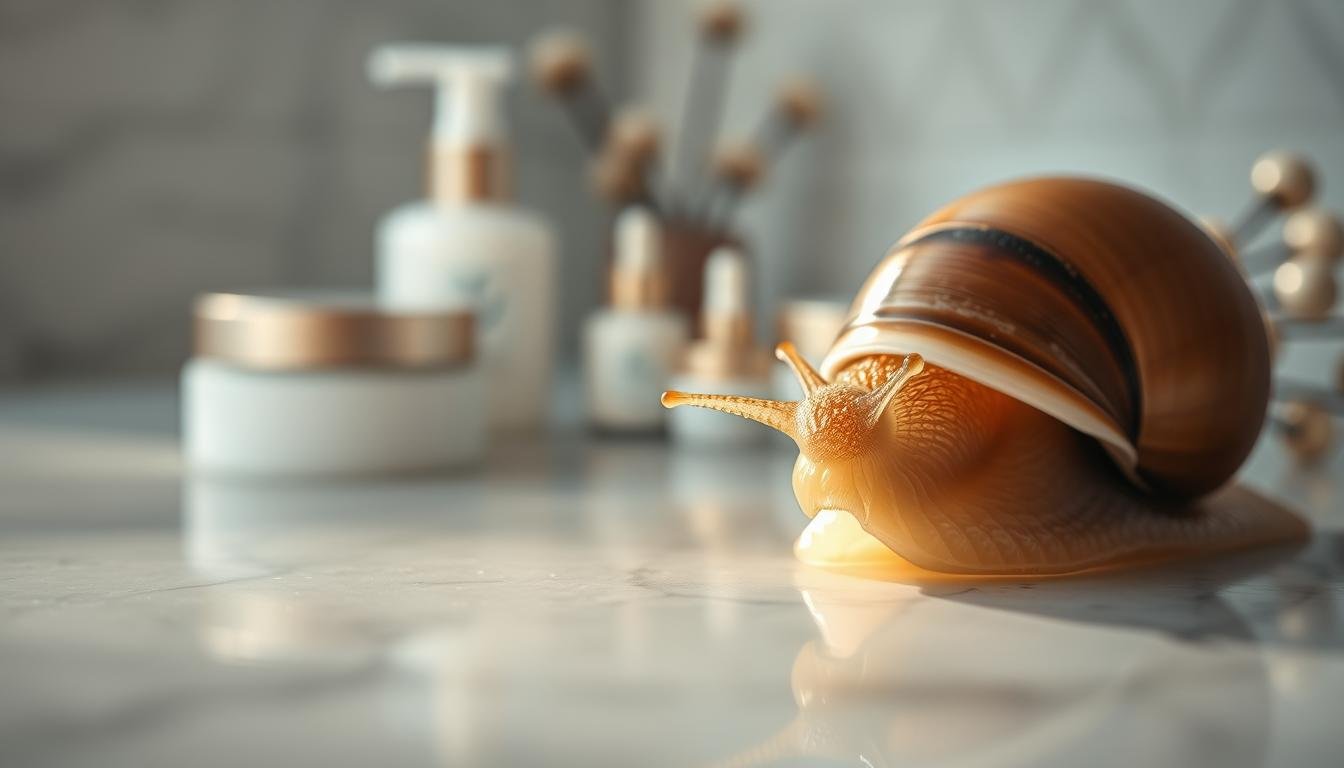Can dipping in icy water really make you feel better? This is a big question in the wellness world. It’s about cold plunge therapy.
Cold plunge therapy, or cold water immersion, is becoming more popular. It’s known for its health benefits. We’ll look into how it can help your body and mind.
Key Takeaways
- Understanding the concept of cold plunge therapy and its growing trend.
- Exploring the potential health benefits associated with cold water immersion.
- Learning how to safely incorporate cold plunge therapy into your wellness routine.
- Identifying potential risks and how to mitigate them.
- Discovering the mental health benefits linked to cold exposure.
What is Cold Plunge Therapy?
Cold plunge therapy is a wellness practice that involves immersing the body in cold water. It aims to stimulate physiological responses. This technique is popular for its potential to improve physical and mental health.
Definition and Overview
Cold plunge therapy, also known as cold water immersion, involves submerging the body in cold water. The water is usually between 50°F to 55°F (10°C to 13°C). It is believed to stimulate various physiological responses that can aid in recovery, improve circulation, and boost mental clarity.
It is often used by athletes to reduce muscle soreness and enhance recovery after intense physical activity. But its benefits are not limited to athletes. It offers a natural and invigorating way to improve overall well-being.
“The use of cold water therapy dates back centuries, with ancient civilizations recognizing its healing properties.” –
Historical Context
The use of cold water for therapeutic purposes has a rich history. Ancient Greeks and Romans used cold water baths as a form of therapy. They believed in its ability to invigorate the body and mind.
| Culture | Historical Use of Cold Water Therapy |
|---|---|
| Ancient Greeks | Used cold water baths for therapeutic and recreational purposes. |
| Ancient Romans | Employed cold water therapy for its invigorating effects. |
| Japanese Culture | Utilized cold water immersion as a spiritual and physical cleansing ritual. |
In recent years, cold plunge therapy has seen a resurgence in popularity. Many wellness centers and athletes incorporate it into their recovery routines. The historical context and modern applications of cold plunge therapy highlight its versatility and enduring appeal.
As the popularity of cold plunge therapy continues to grow, understanding its definition, historical context, and benefits is important. This knowledge can help individuals make informed decisions about incorporating this practice into their wellness routines.
The Science Behind Cold Therapy
Cold therapy works by stimulating the body’s natural responses. This leads to better health and well-being. Cold plunge therapy, in particular, boosts both physical and mental health.
How Cold Therapy Affects the Body
When the body meets cold, it starts to keep its core warm. It does this by vasoconstricting blood vessels. This means less blood flow to the hands and feet, keeping the core warm.
This effort to stay warm increases circulation and boosts the immune system. Cold therapy also makes the body burn more energy. This can help with weight loss by increasing metabolism.
Physiological Responses to Cold Exposure
Cold exposure triggers many body responses. For example, cold showers boost the release of noradrenaline. This hormone can lower inflammation and improve mood.
The body’s natural anti-inflammatory processes kick in too. This can help with muscle soreness and faster recovery after exercise.
The Role of Hormones in Cold Therapy
Hormones are key in how the body reacts to cold therapy. Cold temperatures make the body release hormones like adrenaline and noradrenaline. These hormones increase alertness and energy.
These hormones also help with mental health, reducing stress and anxiety. Cold therapy improves circulation and reduces inflammation. This boosts overall physical health and well-being.
Understanding cold therapy’s science helps us use its benefits. Whether through cold plunge therapy, ice baths, or cold showers, it can greatly improve health and wellness.
Ice Bath Benefits for Physical Health
Ice baths, or cold water immersion, offer many health benefits. They help reduce muscle soreness and improve heart health. Many people use ice baths as a natural way to feel better.
Muscle Recovery and Reduction of Soreness
One key benefit of ice baths is better muscle recovery after working out. Cold water helps lessen muscle soreness, a big problem for athletes. It does this by constricting blood vessels, which reduces swelling and speeds up healing.
Studies show cold therapy is great for athletes. It helps lessen delayed onset muscle soreness (DOMS). This means athletes can train harder and recover faster.
“Cold water immersion is a simple, yet effective strategy for reducing muscle soreness and improving recovery after exercise.”
Improved Circulation and Cardiovascular Health
Ice baths also boost circulation and heart health. When you first get into cold water, your body tries to protect itself by reducing blood flow. But as you warm up, blood flow increases, which is good for your heart.
Regular ice baths can also make your heart work better. They can increase heart rate variability and lower inflammation. These changes can help prevent heart disease and improve your health.
Exploring ice bath benefits shows they can greatly improve physical health. They help with recovery, reduce soreness, and improve heart health.
Mental Health Benefits of Cold Therapy
Cold therapy is now known for its big impact on mental health. Adding cold plunge therapy to your routine can really help your mental health.
Reduced Anxiety and Stress Levels
Cold therapy lowers anxiety and stress by releasing calming neurotransmitters. Taking cold showers regularly can lower stress hormones like cortisol. This makes you feel more relaxed.
The cold stress response also releases neurotransmitters like noradrenaline. These can help with anxiety and depression. This natural response can improve your mental health.
Enhanced Mood and Energy Levels
Cold therapy also boosts mood and energy. The sudden change in body temperature releases neurotransmitters that improve mood and reduce tiredness.
Doing cold therapy regularly can make you feel more energetic. This is because it increases circulation and releases hormones that fight fatigue. This is great for improving mental clarity and overall well-being.
| Mental Health Benefit | Description |
|---|---|
| Reduced Anxiety | Cold therapy helps reduce anxiety by releasing neurotransmitters that calm the mind and body. |
| Enhanced Mood | The release of certain neurotransmitters during cold therapy can improve mood and reduce symptoms of depression. |
| Increased Energy | Cold therapy can increase energy levels by improving circulation and releasing hormones that combat fatigue. |
Understanding the mental health benefits of cold therapy helps you make smart choices. It can reduce anxiety, boost mood, and increase energy. Cold therapy is a natural way to improve your mental health.
Cold Plunge Therapy for Athletic Performance
Cold plunge therapy boosts athletic performance in many ways. It increases endurance and strength. Athletes from different sports use it to get ahead.
Increased Endurance and Strength
Cold plunge therapy has many benefits for athletes. Cold water immersion makes blood vessels smaller. When they warm up, they get bigger, improving blood flow and reducing swelling.
This helps muscles recover faster. It can make athletes stronger and more enduring over time.
It also boosts the body’s repair processes. Hormones like noradrenaline increase alertness and energy. This helps athletes perform better.
How Athletes Use Cold Baths
Athletes use cold baths in different ways. Here are a few examples:
- Post-workout recovery: Cold baths help reduce muscle soreness and speed up recovery after hard workouts or games.
- Pre-event preparation: Some athletes take cold baths before competitions. It helps improve circulation and mental focus.
The table below shows how different athletes use cold plunge therapy:
| Athlete Type | Usage Frequency | Purpose |
|---|---|---|
| Endurance Athletes | 3-4 times a week | Enhance recovery and endurance |
| Strength Athletes | 2-3 times a week | Reduce muscle soreness and improve strength |
| Team Sport Athletes | Post-game and intense training | Aid in recovery and reduce inflammation |
Understanding how cold plunge therapy meets different athletic needs helps optimize training and recovery.
Risks and Precautions of Cold Plunge Therapy
Cold plunge therapy has many benefits, but it also comes with risks. Knowing these risks and precautions is key to using it safely.
Common Side Effects to Consider
Cold plunge therapy can lead to several side effects. Some may be uncomfortable or serious. These include hypothermia, where the body’s core temperature falls below 95°F (35°C).
Other side effects are numbness or tingling in the hands and feet, increased heart rate, and respiratory distress in severe cases.
To avoid these side effects, start with gradual exposure to cold. This lets your body get used to it. Always check your body temperature and watch how it reacts to cold.

Who Should Avoid Cold Therapy?
Some people should not try cold plunge therapy because of health risks. Those with cardiovascular conditions like heart disease or high blood pressure should talk to their doctor first. People with Raynaud’s disease or poor circulation should also avoid it.
Pregnant women and those with diabetes or nerve damage should also get their doctor’s approval. It’s important to think about the benefits and risks. If the risks are too high, there might be other treatments to try.
By knowing the risks and taking precautions, you can safely use cold plunge therapy. This way, you can enjoy its health benefits while avoiding bad effects.
How to Get Started with Cold Plunge Therapy
Starting your cold plunge therapy journey is all about making smart choices. To do it right, you need to know the first steps and what to think about.
Home Setup for Ice Baths
Creating an ice bath at home is easy with the right tips. You’ll need a big tub or container for water and ice. Start with cold water and ice to get the right temperature. Begin with milder temperatures and get colder as you get used to it.
Get a thermometer to check the water’s temperature. This ensures it’s safe for your body.
Choosing the Right Temperature and Duration
The temperature and how long you stay in the bath are key. Temperatures usually range from 50°F to 55°F (10°C to 13°C). Start with warmer temperatures and get colder as you get more comfortable.
| Temperature Range | Recommended Duration | Benefits |
|---|---|---|
| 50°F – 54°F (10°C – 12°C) | 5-10 minutes | Improved circulation, reduced muscle soreness |
| 55°F – 60°F (13°C – 15.5°C) | 10-15 minutes | Enhanced mental clarity, reduced stress |
Listen to your body and adjust the temperature and time as needed. Always talk to a healthcare professional before starting, especially if you have health issues.
Alternative Cold Therapy Methods
There are many ways to enjoy the benefits of cold therapy, beyond just ice baths. It’s important to know about these options when adding cold therapy to your routine.
Cryotherapy vs. Ice Baths
Cryotherapy and ice baths are two cold therapy methods that are getting a lot of attention. They both use cold temperatures, but they work in different ways.
Cryotherapy uses very low temperatures in a special chamber. It’s thought to help with inflammation and recovery by making the body respond to cold.
- Cryotherapy sessions are usually shorter, lasting between 2 to 3 minutes.
- The extreme cold can stimulate the release of certain neurotransmitters that may help reduce pain and improve mood.
Ice baths involve soaking in cold water, usually between 50°F to 55°F (10°C to 13°C), for 10 to 15 minutes. They are great for reducing muscle soreness and helping with recovery after hard workouts.
“Cryotherapy and ice baths both offer unique benefits, and the choice between them often depends on individual preferences and specific health goals.”
Cold Showers and Other Options
Cold showers are another easy way to try cold therapy. They can improve circulation, make you feel more alert, and increase willpower.
- Improved circulation
- Enhanced mental clarity and alertness
- Increased willpower and discipline
Cold showers are easy to fit into your daily routine. The sudden cold can help your body respond naturally, reducing stress and boosting energy.
Other cold therapy options include:
- Whole-body cryotherapy chambers
- Localized cryotherapy for specific areas of the body
- Cold water immersion therapy
Each method has its own benefits and can be chosen based on personal needs. As research grows, we’ll likely see even more cold therapy options.
Integrating Cold Therapy into Your Routine
To get the most out of cold therapy, knowing how to add it to your daily life is key. Cold therapy, or cryotherapy, uses cold to boost your health. It can help reduce inflammation and speed up recovery.

Frequency and Timing Recommendations
Finding the best time and how often to use cold therapy is important. Studies show that regular cold baths or showers can improve blood flow and lessen muscle pain. Athletes find it especially helpful after hard workouts.
- Beginners: Start with 1-2 times per week and gradually increase frequency as your body adapts.
- Athletes: Use cold therapy after intense training sessions or competitions to aid in recovery.
- General Wellness: Incorporate cold showers or baths 2-3 times per week for overall health benefits.
Combine with Other Wellness Practices
Cold therapy works better when paired with other wellness habits. For instance, combining it with meditation or deep breathing can clear your mind and lower stress. Adding physical activities like yoga or cardio can also boost your health and strength.
Here are some ways to mix cold therapy with other practices:
- Follow a cold bath with meditation or mindfulness exercises.
- Make cold showers part of your morning routine to increase energy and blood flow.
- Use cold therapy with physical therapy or rehab to speed up healing.
By carefully adding cold therapy to your routine and mixing it with other wellness habits, you can get the most benefits. This can greatly improve your life quality.
Debunking Myths about Cold Plunge Therapy
Cold plunge therapy is getting more attention, but it’s important to know what’s true and what’s not. This practice involves soaking in cold water. It has been surrounded by myths and misconceptions. We will look at some common myths and provide facts to clear up the confusion.
Misconceptions and Realities
Many think cold plunge therapy is only for athletes. But, it’s not just for athletes. It can help anyone improve their health. Cold water immersion can reduce inflammation, improve blood flow, and boost the immune system.
Some believe cold plunge therapy is dangerous and can cause hypothermia. It’s true that cold water can be risky. But, most cold plunge therapy is done safely. By slowly getting used to the cold and watching body temperature, risks are kept low.
Evidence-Based Insights
Studies show cold plunge therapy has many health benefits. It can reduce muscle soreness and improve mental focus. A study in the Journal of Applied Physiology found cold water immersion after exercise can greatly reduce muscle soreness.
| Myth | Reality |
|---|---|
| Cold plunge therapy is only for athletes. | Anyone can benefit from cold plunge therapy, regardless of their athletic status. |
| Cold plunge therapy is dangerous and leads to hypothermia. | With proper acclimation and safety measures, the risk of hypothermia is minimal. |
| Cold plunge therapy has no scientific backing. | Numerous studies have demonstrated the physiological benefits of cold water immersion. |
Knowing the truth about cold plunge therapy can help people make better choices. It’s important to talk to a healthcare professional before starting, especially if you have health issues.
Cold Plunge Therapy in Popular Culture
Celebrities and athletes are making cold plunge therapy popular. It’s not just about health benefits. It’s also about a cultural shift towards wellness.
This trend is growing fast. It’s thanks to famous people and media coverage. Now, what was once rare is now a common wellness practice.
Celebrity Endorsements and Trends
Wim Hof, known as “The Iceman,” has shown us how to handle cold. He inspires many to try cold therapy.
Celebrities and athletes are big influencers. When they talk about cold therapy, it gets media attention. It also makes their fans curious about it.
Media Coverage and Public Perception
Media has changed how people see cold plunge therapy. Documentaries and interviews have made it clearer and more appealing.
| Media Outlet | Type of Coverage | Impact |
|---|---|---|
| News Channels | Interviews with Experts | Increased Credibility |
| Wellness Magazines | Feature Articles | Raised Awareness |
| Social Media | Influencer Endorsements | Boosted Popularity |
Future of Cold Therapy in Wellness Practices
Cold therapy is becoming more popular in the wellness world. This is because it helps both the body and mind. As scientists learn more, new ways to use cold therapy are being found.
New Frontiers in Cold Therapy Research
Studies are now looking into how cold therapy boosts the immune system and sharpens the mind. It might also help with weight loss. These discoveries could make cold therapy a key part of wellness routines, helping people feel better overall.
The Evolving Landscape
As cold therapy grows in popularity, we’ll see more options for using it. This could include better cryotherapy machines and more places to try it. It will also be added to fitness and wellness programs. This will make it easier for people to use cold therapy to reduce stress and improve their health.



